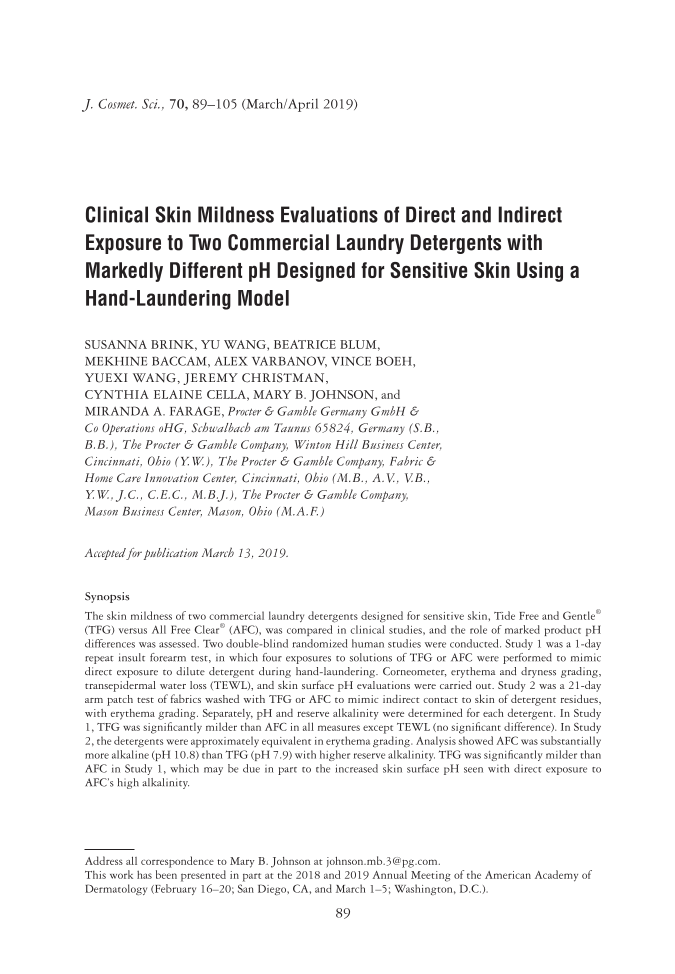J. Cosmet. Sci., 70, 89–105 (March/April 2019) 89 Clinical Skin Mildness Evaluations of Direct and Indirect Exposure to Two Commercial Laundry Detergents with Markedly Different pH Designed for Sensitive Skin Using a Hand-Laundering Model SUSANNA BRINK, YU WANG, BEATRICE BLUM, MEKHINE BACCAM, ALEX VARBANOV, VINCE BOEH, YUEXI WANG, JEREMY CHRISTMAN, CYNTHIA ELAINE CELLA, MARY B. JOHNSON, and MIRANDA A. FARAGE, Procter & Gamble Germany GmbH & Co Operations oHG, Schwalbach am Taunus 65824, Germany (S.B., B.B.), The Procter & Gamble Company, Winton Hill Business Center, Cincinnati, Ohio (Y.W.), The Procter & Gamble Company, Fabric & Home Care Innovation Center, Cincinnati, Ohio (M.B., A.V., V.B., Y.W., J.C., C.E.C., M.B.J.), The Procter & Gamble Company, Mason Business Center, Mason, Ohio (M.A.F.) Accepted for publication March 13, 2019. Synopsis The skin mildness of two commercial laundry detergents designed for sensitive skin, Tide Free and Gentle® (TFG) versus All Free Clear® (AFC), was compared in clinical studies, and the role of marked product pH differences was assessed. Two double-blind randomized human studies were conducted. Study 1 was a 1-day repeat insult forearm test, in which four exposures to solutions of TFG or AFC were performed to mimic direct exposure to dilute detergent during hand-laundering. Corneometer, erythema and dryness grading, transepidermal water loss (TEWL), and skin surface pH evaluations were carried out. Study 2 was a 21-day arm patch test of fabrics washed with TFG or AFC to mimic indirect contact to skin of detergent residues, with erythema grading. Separately, pH and reserve alkalinity were determined for each detergent. In Study 1, TFG was signifi cantly milder than AFC in all measures except TEWL (no signifi cant difference). In Study 2, the detergents were approximately equivalent in erythema grading. Analysis showed AFC was substantially more alkaline (pH 10.8) than TFG (pH 7.9) with higher reserve alkalinity. TFG was signifi cantly milder than AFC in Study 1, which may be due in part to the increased skin surface pH seen with direct exposure to AFC’s high alkalinity. Address all correspondence to Mary B. Johnson at johnson.mb.3@pg.com. This work has been presented in part at the 2018 and 2019 Annual Meeting of the American Academy of Dermatology (February 16–20 San Diego, CA, and March 1–5 Washington, D.C.).
JOURNAL OF COSMETIC SCIENCE 90 INTRODUCTION Sensitive skin is prevalent among consumers. In surveys in the United States, Europe, and Asia, almost half of people reported having sensitive skin (1–4). The symptoms of sensitivity are varied, including stinging, redness, roughness, scaling, and itching (5–8). Certainly, direct contact to skin irritants can trigger sensitivity responses. Also, airborne materials such as smoke and chemicals can become trapped in fabrics and, thus, elicit skin responses when the fabrics contact the skin (9–12). Thus, frequent cleaning of clothes is important to dramatically reduce exposure of the skin to these irritating materials (9–11). Although clean clothes are important to help avoid skin sensitivity issues from environ- mental irritants, indirect exposure through detergent residues on fabrics may also con- tribute to the problem (5,13). In addition, extensive direct exposure to detergent may occur during hand-laundering, and during prewashing and pretreating of fabrics before using a commercial washing machine. Ingredients such as dyes and perfumes are fre- quently reported triggers of sensitive skin, and as such, several commercially available laundry detergents designed for sensitive skin (known as “free detergents”) are formu- lated without these ingredients. Notably, 80% and 97% of dermatologists in the United States and Canada, respectively, recommend the use of free detergents to their patients with sensitive skin. (US data are based on IQVIA (Durham, NC) ProVoice January 2018 cumulative 12-mo data. Canadian data are based on an Internet survey conducted in January 2018 of 150 dermatologists licensed to practice in Canada.) Although out- right contact dermatitis from laundry detergents is a rare event, occurring in less than 1% of sensitive-skin patients (14,15), it is still important to understand the potential for irritation from detergent products because these products do come into direct and indirect contact with the skin. Although there are many methods to evaluate detergent effects on the skin, from simple laboratory tests to in vitro evaluations such as cell culture, the most relevant to real-world skin responses are observations in controlled clinical studies (5). Recently published work (16,17) proposes using a specifi c set of in vitro methods (zein protein denaturation test, cell culture cytokine release test, and corneosurfametry measure of protein and lipid deg- radation) as suffi cient to assess product mildness of laundry detergents designed for sensi- tive skin. By contrast, in this report, we describe clinical mildness comparisons of direct and indirect exposure to the two U.S. market-leading, commercially available free laun- dry detergents, both of which are designed for sensitive skin and which have markedly different pH values. (U.S. market leadership is based on 2017 retail sales, Nielsen laun- dry detergent category.) Both products are formulated as liquid detergents and as laundry detergent pacs encased in a dissolvable membrane. We conducted two clinical studies: one a mini-immersion, repeat insult test modeling direct exposure to the skin during hand-laundering of garments using dilutions of the liquid formulations of the two deter- gents and the other a patch test modeling prolonged exposure to detergent residues on fabrics after machine washing using either the liquid or pac formulations of the two de- tergents. Although laundry formulations are complex and many factors and ingredient components can play a role in skin mildness, pH has been cited as a concern for irritation in sensitive-skin individuals (18,19). Therefore, we explored whether pH differences may help explain the skin mildness effects observed in the clinical studies by analyzing the pH and reserve alkalinity of the liquid formulas and the pH of fabrics washed with the liquid formulas.
Purchased for the exclusive use of nofirst nolast (unknown) From: SCC Media Library & Resource Center (library.scconline.org)

















































